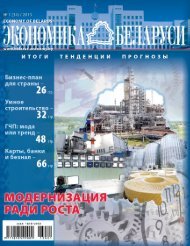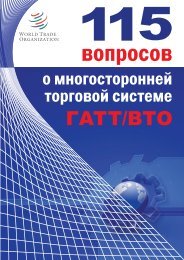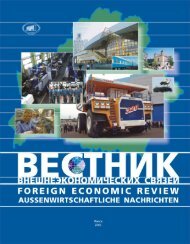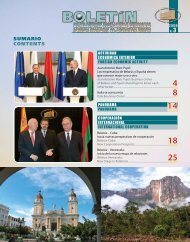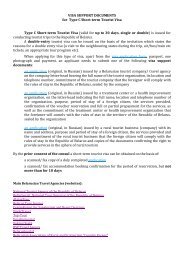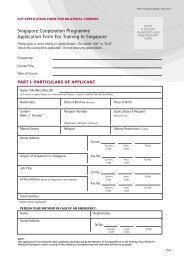Human Development Report 2013 - UNDP
Human Development Report 2013 - UNDP
Human Development Report 2013 - UNDP
Create successful ePaper yourself
Turn your PDF publications into a flip-book with our unique Google optimized e-Paper software.
ecause population growth outpaces economicgrowth.Less developed countries can learnand benefit from the success ofemerging economies in the SouthThe unprecedented accumulation of financialreserves and sovereign wealth funds inthe South ($6.8 trillion) as well as the North($3.3 trillion) provides an opportunity toaccelerate broad-based progress. Even a smallportion of these funds dedicated to human developmentand poverty eradication could havea large effect. As mentioned, public investmentin South Asia and Sub-Saharan Africa couldincrease to 11.7% of GDP using just 3% ofinternational reserves from some of the largesteconomies in the South.At the same time, South–South trade andinvestment flows can leverage foreign marketsin new ways, such as participating in regionaland global value chains to facilitate the spreadof ideas and technologies. Burgeoning South–South trade and investment in particular canlay the basis for shifting manufacturing capacityto other less developed regions and countries.Recent Chinese and Indian joint ventures andstartup manufacturing investments in Africaserve as a prelude to a much expanded forcethat this potential represents. To harness thefull extent of this potential, new and innovativeinstitutions may be called for. Internationalproduction networks provide opportunities tospeed up the development process by allowingcountries to leap-frog to more sophisticatedproduction nodes while offering the doublebenefit of protection against the vagaries offoreign exchange fluctuations.South–South development cooperation andtechnology transfer hold immense potentialto support human development. Technologytransfers from the North require costly adaptationdue to differences in absorptive capacity,but technological transfers within the Southare more likely to need little adaptation andto involve more-appropriate technologies andproducts. Growing markets in developingcountries provide companies in the South anopportunity to mass market innovative andaffordable versions of standard products, includingfood, clothing, appliances and motorvehicles. Importantly, the sharp drop in theprice of capital goods as a result of intenseglobal competition led by China and Indiacould accelerate the creation of manufacturingproduction capacities in many developingcountries. Such production can be adapted tothe income levels and tastes of local consumers.This dynamic has the potential to providethe poor access to consumer goods, whileinnovators create jobs and develop producercapabilities.New institutions and new partnershipscan facilitate regional integrationand South–South relationshipsNew institutions and partnerships can helpcountries share knowledge, experiences andtechnology.In finance and aid, the South is alreadyactively establishing regional governance institutions.Regional alternatives to the IMF, suchas the Chiang Mai Initiative Multilateralizationand the Latin American Reserve Fund, havefreed up policy space for countries to protectnational priorities while also addressingbalance- of-payments problems and short-termliquidity issues.The foundations exist for strong regionalinstitutions, but more can be done to accelerateand deepen these relationships and ensure inclusiveness.As wealthy countries have curtailedaid to address domestic issues, regional developmentbanks and bilateral aid relationshipsprovide additional resources for developmentprojects. These new aid mechanisms alsotend to emphasize pragmatism over ideology.Infrastructure development banks, for example,offer new possibilities for development finance.Brazil, China, India, the Russian Federationand South Africa have proposed a developmentbank to mobilize their considerable reserves tofinance projects across developing countries.Building infrastructure would be an importantuse of such reserves.Trade with other developing countries nowaccounts for a majority of merchandise andmanufactures exports from developing countries,and these exports are increasingly skillandtechnology-intensive. Stronger institutionsare now needed to facilitate these South–South trade and investment links. ExpandedThe foundations existfor strong regionalinstitutions, but more canbe done to accelerateand deepen theserelationships andensure inclusivenessChapter 5 Governance and partnerships for a new era | 121



